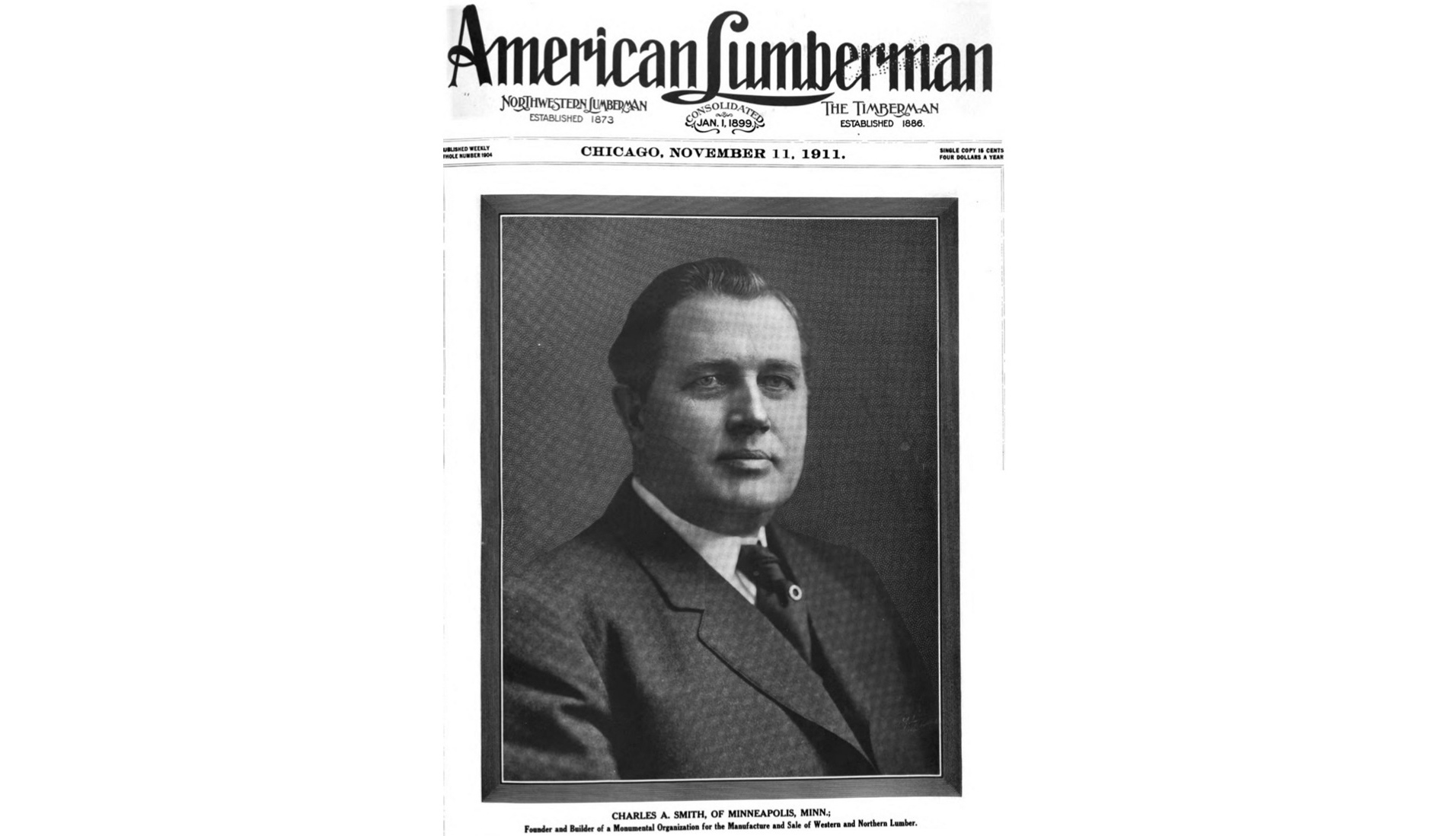Part II – The Rise and Fall of Smith Lumber

The Nov. 11, 1911 issue of American Lumberman hailed the exploits of Charles A. Smith, the success story of the Swedish immigrant who created a lumber empire. Of note in the digital version of this article, particularly in the summary on the last page, was the high expectation of the great accomplishments to be realized in the near future. https://babel.hathitrust.org/cgi/pt?id=uc1.c032692376
L140-05-Courtesy the Hathi Trust Digital Library, (Image 1 of 13)

After moving west in the 1907 timeframe and expanding mill operations in Marshfield, Oregon, or “Coos Bay”, the delay of Southern Pacific’s planned rail service there forced Smith to look elsewhere to distribute and ship products. Bay Point’s water access and transcontinental railroads provided the perfect place, and by adding a planing mill and a box factory, seen here, his exodus to the west was complete.
L140-10 Courtesy Contra Costa County Historical Society, 109 , (Image 2 of 13)

The 450 miles between Coos Bay and Bay Point forced Smith to invest in steamer transportation. The larger of the company’s initial steamers, the Nann Smith, named after one of his daughters, was said in the American Lumberman article to make “round trips every six days ... carrying capacity of 2,250,000 feet of lumber and a speed of twelve knots.”
L140-15-Courtesy BAERA, Western Railway Museum Archives, 95563cv, (Image 3 of 13)

Lumber at the dock, as shown here, was placed on trucks or railroad flatcars and eventually made its way through the industrial operation, eventually reaching the 4300 feet to the Santa Fe or Southern Pacific railroads.
L140-20-Courtesy BAERA, Western Railway Museum Archives, 95559cv, (Image 4 of 13)

“The first car of lumber was shipped from the Bay Point plant Sept. 1, 1908”, according to the American Lumberman article. By May, 1911, 229 were employed at the Bay Point operation. The town was growing and the prospects for the future seemed bright. The presence of the railroad bridge at the left middle border dates this north view to after 1918.
L140-25-Courtesy Contra Costa County Historical Society, 106 , (Image 5 of 13)

But all was not well. As Harold G. Robbins outlined in “Hard Times in Paradise: Coos Bay Oregon”, although production increased from 1907-1911, the lumber industry began a period of low prices and overproduction. Add to this debt from its timber holdings, taxes and capital investments, “Charles Axel Smith was overextended”. By 1915-1916, creditors and investors in San Francisco and Chicago pushed him aside and reorganized his holdings to a new company, “Coos Bay Lumber”.
L140-30-Courtesy Contra Costa County Historical Society, 537 , (Image 6 of 13)

Smith’s other Bay Area connection was his operations in Oakland. Initially in offices in San Francisco, in Sept. of 1911 he moved his corporate offices to 711 Realty Syndicate Building, the Beaux Arts building of Borax Smith fame, still located at 1420-44 Broadway. As this map from 1921 shows, he also set up lumber operations to the south of the Western Pacific’s rail operations.
L140-35-Central National Bank Map, Courtesy BAERA, Western Railway Museum Archives, 83537 , (Image 7 of 13)

The Coos Bay name survived as an entity in Oakland based on a search through Polks Oakland City Directory into the mid-1930s. It was noted to be last located at the foot of 9th Ave. Pictured is a 1920s northwest view of the lumber yard to the west of the Moore Shipbuilding Co. Ref: API 651_9_BOX 95059
L140-40-George Russell Photo, Courtesy California State Lands Commission, (Image 8 of 13)

As a point of clarification, a Smith Lumber Co. did co-exist in Oakland at the foot of 18th-19th Aves., but it had no relation to Charles A. Smith. Ref: API 529_1_BOX 61006
L140-45-George Russell Photo, Courtesy California State Lands Commission, Detail, (Image 9 of 13)

Back to Bay Point, existence of photographic evidence showing dismantling of the Coos Bay operation has not been found. The standard USDA aerial from 1939 shows buildings in that location. Definitive aerials, such as those by George Russell, date to circa 1929 based on the progress of the construction of the Southern Pacific’s train bridge seen in the distance in the upper right of this east view. Ref: API 563_15_BOX 59119
L140-50-George Russell Photo, Courtesy California State Lands Commission, (Image 10 of 13)

A similar view circa 1929, but more to the southeast with the Coos Bay Lumber Co. taking center stage. Many history books and articles date the departure of Coos Bay Lumber from Bay Point as 1932, and date the start of construction on this site by the Navy as 1942. The SF Chronicle of Saturday Aug. 1, 1931 noted that Coos Bay Lumber sold 111 acres to the Armstrong Cork Co. of Lancaster, PA to manufacture linoleum. Ref: API 563_13_BOX 59118
L140-55-George Russell Photo, Courtesy California State Lands Commission, (Image 11 of 13)

A south view circa 1929 of the deep water frontage measuring 2,658 feet across with a steamer at port, and the industrial space to the rail lines of 4,300 feet, much of it taking advantage of Bay Point’s favorable climate for drying and aging of the lumber. Ref: API 563_17_BOX 59120
L140-60-George Russell Photo, Courtesy California State Lands Commission, (Image 12 of 13)

Finally this detail of 138-60, south view circa 1929, showing an intact “Burgess’ Bridge” to Pacific Coast Ship Building Co. The neighbor to the west of Coos Bay will be the topic of the next part of this history. Special appreciation for the contribution of Matt Fossum and the California State Lands Commission. Ref: API 563_17_BOX 59120
L140-65-George Russell Photo, Courtesy California State Lands Commission, Detail , (Image 13 of 13)